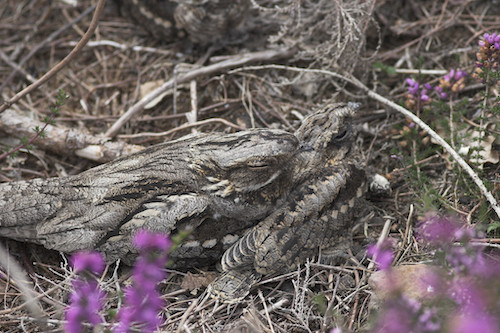
Summer visitors to the UK, the churring call of the male nightjar is an iconic sound of warm heathland evenings.
Photo: © Natural England/Allan Drewitt
Scientific name: Caprimulgus europaeus
Other common names: European Nightjar, Goatsucker
Conservation status: UK conservation status: Amber
What to look for:
- Family: Nightjars
- Colouring and appearance: Mottled and streaky brown and grey colouration; pointed, long wings; brown feet and legs
- Size: 26 to 28 cm length, 57 to 64 cm wingspan.
- Where: Heathland, woodland clearings, new or recently felled plantations, mostly across southern England but with an expanding range
- Call: A fast churring
- Similar species: Cuckoo, Kestrel (due to shape of wings and tail)
Nightjars are the champions of stealth. They are nocturnal, with mottled brown feathers that melt into the dim light of dawn and dusk as they hunt on silent wings for their insect food. Their colouration is cryptic by day, too. A ground-breeding species, the female (and occasionally the male) sits on her nest among the undergrowth, still and quiet, blending into the surroundings.
It is, however, not possible to miss the churring rise and fall of the male’s call. An iconic sound of heathland evenings in the summer, the long trill (the male can keep the call going for up to ten minutes at a time) sometimes ends with wing-clapping (you can hear this on the xeno.canto audio file indicated above), the sound of which is produced by a whiplash effect, rather than the wings actually clapping together.
Nightjars are summer visitors to the UK. The males get here first in order to establish territories, which they defend vigorously against competitors. Display flights – spiralling on V-shaped wings with fanned tails – mark the arrival of the females. One or two eggs are laid directly onto the ground among roots or plants, with no nest, and are mainly incubated by the female for a period of about 18 days. The pair sometimes produce a second brood.

The video below, filmed in June 2023, is of a male Nightjar, circling, perching and calling at Drytree. Croft Pascoe is another good place to see and/or hear Nightjars, but always take care not to disturb the birds by keeping to the main paths.
Did you know…?
…The genus name – Caprimulgus – is a reference to the myth that Nightjars suckled goats, causing their milk to dry up.
More information and references:
Svensson, L., Mullarney, K., Zetterstrom, D.,1986. Collins Bird Guide, second edition (translated by Christie, D., Svensson, L.). HarperCollins, London.
Published: June 2023
Author: Amanda Scott
Photo: © Natural England/Allan Drewitt
